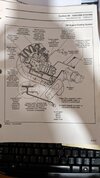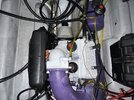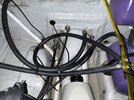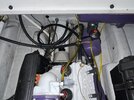mejim707
Active Member
This is a specific issue for a specific problem and please consider this as a question for a specific issue and please don't move / merge / delete this post.
I've identified an issue where starting on water was impossible because water was actively pouring into the exhaust due to a siphoning effect after running the boat for a while. After comments and suggestions I tied the inlet hoses in a high loop to break the siphon. This has mostly resolved the issue.
However, it seems that the issue is still happening occasionally. Even though I have the hoses tied in a high loop. the siphoning is still occurring rarely and I hear water pouring into the resonator. Most of the time it's fine, but you know that one time it happens and I don't check I will be on a far away dock and I'll be stranded. For now, I will have no choice but to clamp off the hoses every time I stop the boat to 100% ensure the water stops siphoning in.
The question is, why when you shut the engine off does the engine allow the water to continue pouring / siphoning in? How could this happen with my engine and boat and doesn't seem to be happening for others. I've seen many pictures of peoples engine bays for these boats and I've only seen 1 where the hose is long enough and it looks like the inlet hose from the jet pump is tied in a high loop.
Something is causing the water to continue flowing even though the engine is off. Something that I don't know of is causing a suction affect the continues to draw in water until I physically break the siphon by clamping the water hoses.
I'm reaching out to the pros here since you all know these engines on a level that you may know why this endless loop would happen, only after running for a while then shutting the engine off.
I mean I could add more hose and elevate that 10 feet above the boat to make sure this never happens again but I don't think I should have to keep elevating this high loop even higher when there must be something else at work here.
Thank you in advance!
I've identified an issue where starting on water was impossible because water was actively pouring into the exhaust due to a siphoning effect after running the boat for a while. After comments and suggestions I tied the inlet hoses in a high loop to break the siphon. This has mostly resolved the issue.
However, it seems that the issue is still happening occasionally. Even though I have the hoses tied in a high loop. the siphoning is still occurring rarely and I hear water pouring into the resonator. Most of the time it's fine, but you know that one time it happens and I don't check I will be on a far away dock and I'll be stranded. For now, I will have no choice but to clamp off the hoses every time I stop the boat to 100% ensure the water stops siphoning in.
The question is, why when you shut the engine off does the engine allow the water to continue pouring / siphoning in? How could this happen with my engine and boat and doesn't seem to be happening for others. I've seen many pictures of peoples engine bays for these boats and I've only seen 1 where the hose is long enough and it looks like the inlet hose from the jet pump is tied in a high loop.
Something is causing the water to continue flowing even though the engine is off. Something that I don't know of is causing a suction affect the continues to draw in water until I physically break the siphon by clamping the water hoses.
I'm reaching out to the pros here since you all know these engines on a level that you may know why this endless loop would happen, only after running for a while then shutting the engine off.
I mean I could add more hose and elevate that 10 feet above the boat to make sure this never happens again but I don't think I should have to keep elevating this high loop even higher when there must be something else at work here.
Thank you in advance!







